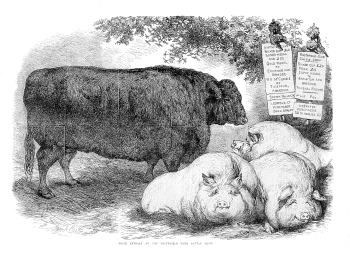A note on brine for pork or possibly beef.
Brining is big. Practitioners include not only the celebrated London restauranteur Fergus Henderson but also any number of down home southern cooks. Caribbean cooks like brines too; the region always has had a taste for what others consider extremes of salt and sweet, a holdover from the days of the sugar economies. By the end of the seventeenth century, so much ground was given to cane that planters imported food, and much of imported food was preserved, most commonly either salted and dried, or steeped in salt brine.

We are of several minds about brine. Nothing beats good commercial corned beef, and the Editor looks forward to laying down traditional English spiced beef each year in December. Hams of course are either brined (‘city’ cured) or dry (‘country’) salted. Home brining, however, is a trend of the hour, for texture and flavor. It is quick and easy; adherents claim that it tenderizes pork in particular, and keeps contemporary leanbred meat from drying out.
Brine does, however, alter the taste of meat, and will impart a pronounced jolt of salt however assiduously you rinse your quickly cured cut. The salt is less noticeable for simmered meats, but briniacs roast and grill their creations too. That is where some trouble starts. Meat kept under brine can obtain a mushy cast when roasted, and grilling tends to concentrate the harshness of salt. You can avoid these problems if you only leave your meat submerged for a short time, but then the point is lost; you cannot notice much difference in taste, and the salt will not have been given time to break into and down the connective tissue to tenderize the meat.
Brined pork tastes a lot like commercial city ham, whatever cut you decide to pickle, from the leanest loin to the most unctuous belly, which in a way is no bad thing; at least you know what went into you own concoction, and it is undeniably fun to tinker, if at a cost in failure rate.
We seldom like any of the many recipes currently circulating online and in print for home brined meats, not even Henderson’s, although it must be said that in the main he restricts his usage of brined meats to boiling, as noted a sensible precaution. He likes to flavor his solution with juniper, and uses only white, never darker, sugar. No molasses either, and no booze.

Nonetheless we do like brined meats in moderation. Salt pork rather than the clam is indispensable to chowder, and baked beans require a slab of the stuff nestled in the center of their pot. Nineteenth century Yankee cooks liked to serve bits of fried lean salt pork (basically the same thing as modern pickled pork) with apples fried in the rendered fat. Louisiana cooks flavor all manner of gumbo, soups and stews with pickled pork, a cheap and estimable product that apparently refuses to travel out of state. You can obtain it online, however, and it freezes well.
If you want to pickle some pork or otherwise use a brine, the Editor’s basic recipe is as good an example as any other.
Basic brine.
-3 Tablespoons salt
-3 Tablespoons Turbinado or Demerara sugar
-1 cup boiling water
-2 Tablespoons neutral oil
-a peeled and chopped onion
-about 6 whole allspice berries (dried is suitable)
-2 or 3 bay leaves
-3 cloves
-about a dozen whole peppercorns
-½ cup Bourbon or rum
-1 ½ cups tepid water
- Put the salt and sugar in a heavy pot, pour in the boiling water and whisk the solution until the solids have dissolved. You may or may not need some heat under the pot.
- Turn off the heat.
- Add the oil, the remaining solids, then the booze, and stir it all together.
Notes:
- Proportions remain constant if you need more brine.
- The booze adds a nice touch but lots of brines omit it. Your choice of spirit depends, commonsensically, on your ultimate recipe.
- Fergus Henderson does like his juniper; if you do too, then substitute a like number of juniper berries, which also may be dried, for the allspice. You might then also substitute gin for the Bourbon or rum.
- If, like Henderson, you prefer white sugar, go ahead and use it. It would be more compatible with juniper and gin.
- If you are brining pork chops for the grill (not a bad move given their tendency to dry to dusting leather), do not let them bathe too long, no more than a couple of hours, and then rinse them obsessively or the salt will overwhelm you. If you want to boil your salted pork, or even roast it, you can leave it longer, but not too long for roasting. Overnight is not overwhelming for the boiling pot.
It is easy to fry salt pork and apples but you will need either to pickle your own or buy some online; the ‘salt pork’ next to the bacon in the supermarket is a modern iteration far fattier and even more heavily salted than the product used in the old recipes. This recipe belongs to Lydia Maria Child, from her American Frugal Housewife (Boston 1833):
“Fried salt pork and apples is a favorite dish in the country, but it is seldom seen in the city. After the pork is fried, some of the fat should be taken out, lest the apples should be oily. Acid apples should be chosen, because they cook more easily; they should be cut in slices across the whole apple, about twice or three times as thick as a new dollar.”
Perhaps a little explication might help. The pickled pork we get or make is not that fatty; you will need a little neutral oil or, better, lard. The Editor uses thin hunks of salt pork; they need not be too uniform. If you do not have an apple corer, split your apple and slice it into half rounds about 3/8 to ½ inch thick. Whether or not you peel them is up to you. Despite Child’s pointer about acidity, any apple will do.
- At Thanksgiving time, the turkey briners come out of the woodwork to advise the fearful how not to dry their birds. The fear is understandable; most people roast a turkey but once a year, and do it under the pressure of many diners. We hate brining a turkey, however. If roasting one scares you, boil it instead according to the reliable britishfoodinamerica recipe in the practical archive.

